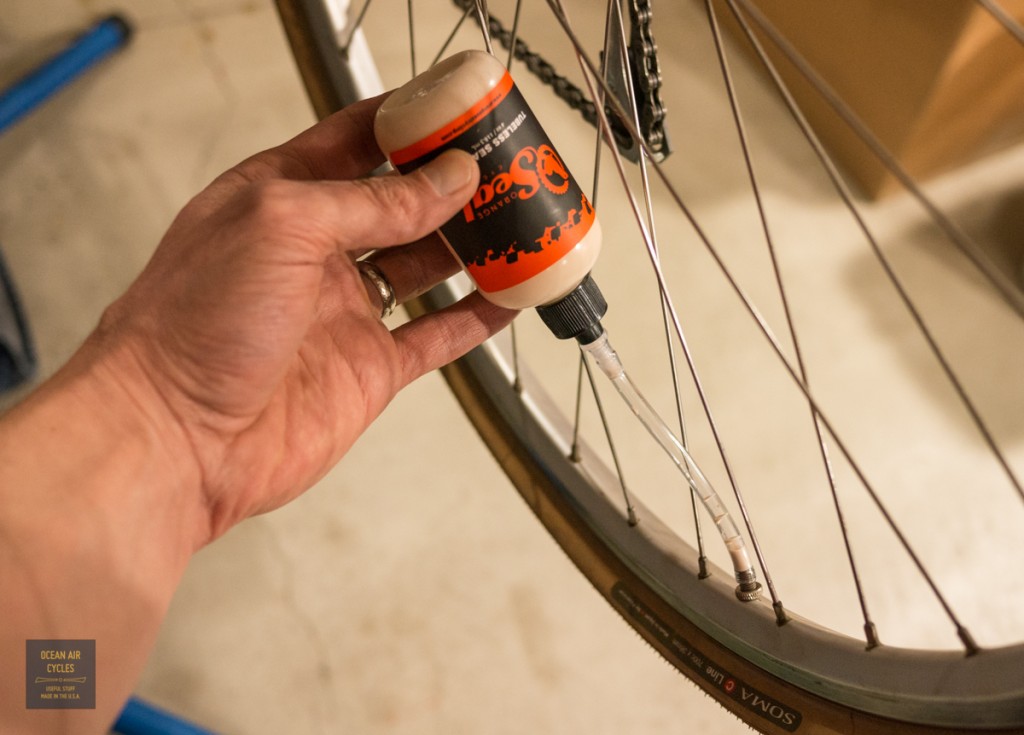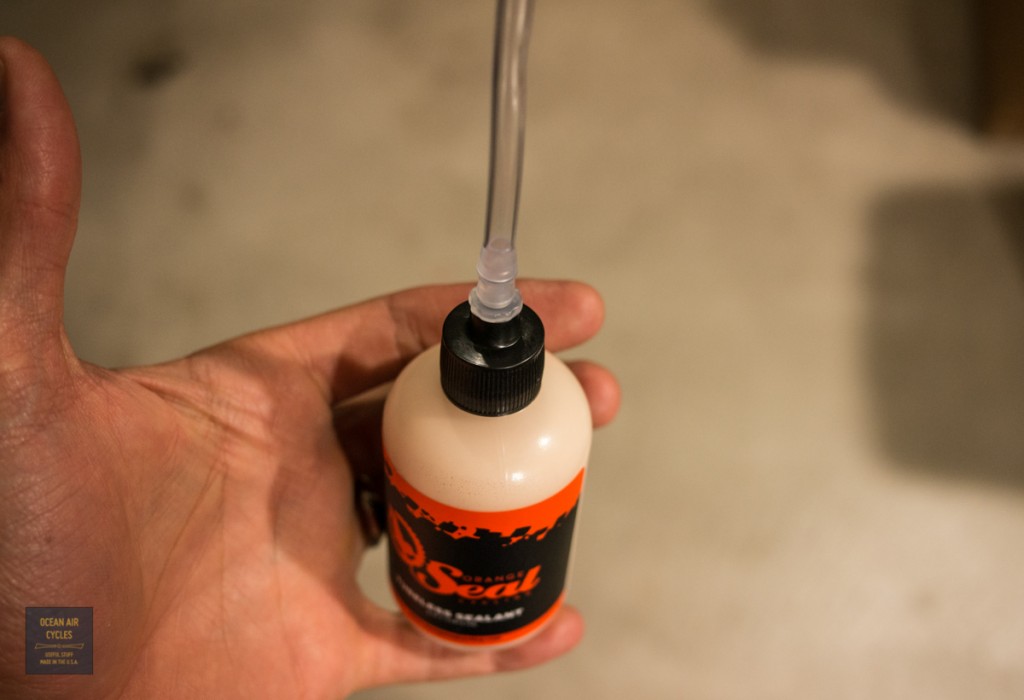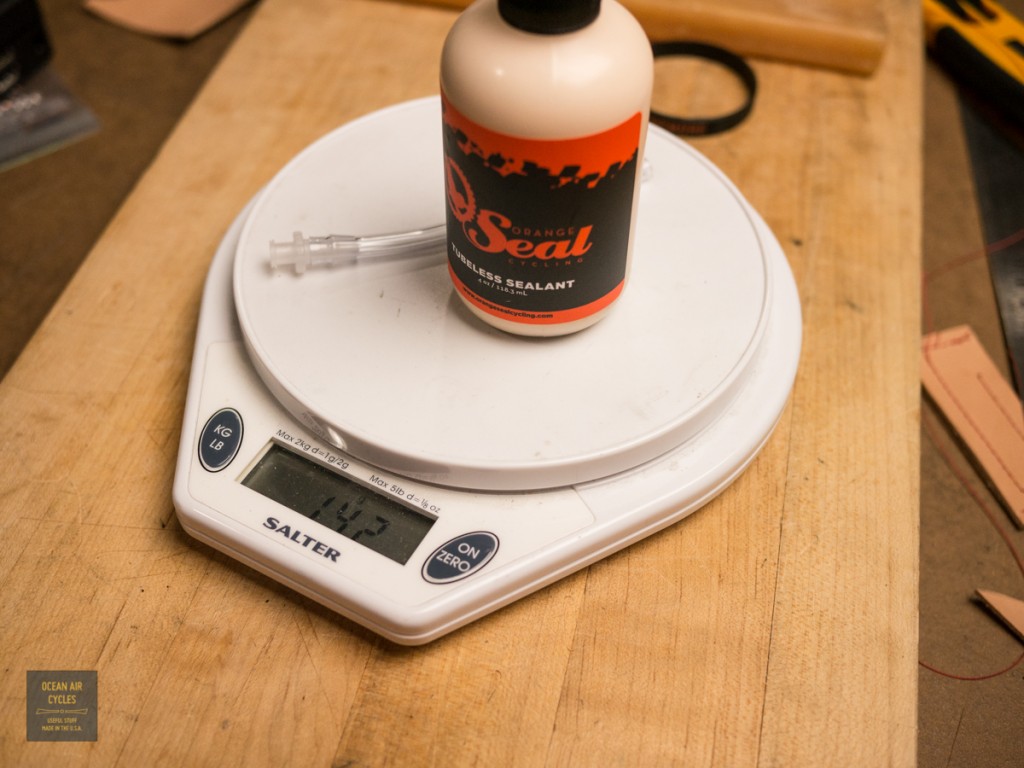The tubeless tire setups common in the MTB world have been slowly starting to creep into the fat tire road bike niche. The benefits of weight savings, running lower pressures and near flat-proofness all translate to some degree. I have been asked, and do not recommend that the commonly available 38-40mm tires be set up tubeless for most riders. The risk of failure is too high for most of us. That said, today I did this:
 Things are not always what they appear though.
Things are not always what they appear though.
There are a few perimeters that all come into play to make tubeless setups work. Removing the rim from this discussion for now, the tire generally needs a bead that has near zero stretch, and a sidewall/casing with a butyl liner to protect it from the solvents in the tubeless compound. Tubeless setups are generally run at lower pressures for improved traction and comfort. The sealing solution is meant to seal up any small gaps in the system, but also seals any punctures along the way.
That all sounds great for what we want out of our light and supple 38mm tires. I brought this up a few years back while talking with Kirk Pacenti ant NAHBS. He has a strong grasp of tubeless design and had recently launched his 650b PariMoto tire. The first problem is with the tire itself. To make them proper for tubeless they have a butyl liner bonded to the inside of the tire. With large MTB tires this liner is significantly lighter than the tube it replaces. As the tire gets smaller the point of diminishing returns is approached. The available super light tubes weigh about the same (100-120g) as that the liner and a full load of sealant would weigh. The zero stretch bead needed adds further weight. Then there is the pressure consideration. Riders at or over 180 lbs will likely be running pressures greater than 45psi. this pushes the limits of where non-tubless tires will stay on the rim without a tube.
So what did I do to my wheels this afternoon? With the goathead thorn season getting ready to ramp up and some dirt road group rides planned I wanted to add a bit of insurance to my system. I decided to take as much of the good as I could and set up an optimized system for the 38mm tires and my weight (210 lbs). Starting with the Velocity A23 tubeless rim, the secure tubeless ready fit gives a snug fit with the tire bead. The Soma C Line tires are one of the widest, light 380g, and supple 700c tires on the market at the moment. I opted for the super light Q tubes at about 120g each for the 700x 35. This set up alone has been going great for months now. Taking it to the next steep in flat protection I added 2 oz, half the normal amount for a full sized MTB tire of Orange Seal to each Tube. This will add about 70g to each tire, less than standard tube and aramid liner.
The process was simple. Let the air out to the tire, having a presta nut on will help later
 Next up grab a 4mm wrench and remove the valve core from the stem.
Next up grab a 4mm wrench and remove the valve core from the stem.

 Insert the plastic end of the supplied hose onto the well shaken bottle of sealant
Insert the plastic end of the supplied hose onto the well shaken bottle of sealant
 And the other end goes over the stem. Invert the bottle and squirt in about half.
And the other end goes over the stem. Invert the bottle and squirt in about half.
Turn the bottle right side up an detach the hose. Re-install the valve core and inflate to the desired pressure. I keep my C Lines between 55 and 60 psi. Repeat on the other tire and ride. It is that simple.
What are the gains in theory, and how is this different than a basic Slime brand pre-filled inner tube? The whole system is optimized to be light and supple for decreased rolling resistance. The level of safety is high. Time will tell if there is improved air retention and flat protection. The end is a system with all of the good parts of each improvement and less risk to safety.
There have been reports of successful tubeless setups with 42m tires and lower pressures. I suspect the rider weight and load were also correspondingly lower. While there have been successes, there have also been failures. The tires and pressures we are using on “Rando” bikes are close to the margins of safety for tubeless design. The price of failure is high. Failure being the front tire coming off of the rim at speed with total loss of air pressure. While I want improved performance as much as the next rider, I do not think tubeless is the right choice for our needs. I am looking forward to increased flat protection while having the piece of mind that my tire is far more likely to stay on the rim.

Excellent! I’ve thought about doing this for my 2.25″ SmartSams on my Hunqapillar. Great to know it is doable. Will love to hear how you do with flat protection.
Somewhere buried in the google groups Patric in New Mexico did this with his higher volume tires, then ended up join gull tubeless. He documented a good bit of the journey, but I am not finding it at the moment, possibly on the ibob list
I would think you could use a smaller ultralight tube than the 35mm. The sealant should help with air retention.
the next step is the Super light 28-35 tubes, I have used them in the past with good luck, the sealant should just make it even better
I like the look of this & will try it. This is what you mentioned at the Orange Steel Bike Show, right?
dougP
Yes, exactly what we talked about in Orange, but just getting the time to implement it. As great as tubeless sounds, there is nobody doing it above 50 psi. With tires under 40mm wide it is marginally worth the effort. The only real gain, and a quite valid one, is being able to ride through goat head throne with reckless abandon.
What SL/UL tubes do you recommend? I tend to like Conti tubes, but they have so many different models. Curious what y’all like. I’ll be running 32c tire.
I have been happy with the blue box Light Weight Q Tubes. They generally come out of the box with Hutchinson info printed on the tube. For the price they do fine and do not generally leak at the slow rate some SL tubes do. The best in general are the Schwalbe, but they cost twice as much. If this round of sealant in a tube foes well my next stem is a narrower SL Q Tube with sealant, the weight will be less than a Schwalbe and theoretically flat proof
Rob, Curious why you like the Soma C-Line over the Panaracer Pasela? Both are made by Panaracer and seem to have very similar tread patterns. I guess maybe the weight? The 32 Pasela weighs the same as the 38 C-Line.
Brian, The C Line has a folding bead and no additional puncture strip, a combo not available in the Pasela for a long while now. Also, the tread band on the C Line is that of the 35mm tire on the 37mm casing, shaves weight only putting the rubber where you need it and increases the supple sidewall effect. There is a noticeable improvement in feel and weight from the 700×38 Soma New Express. Making a few tweaks to the overall design allowed Soma to get a high performing tire without the initial move to a new mold
Rob,
#CoffeeOutside looks great!
In my experience, liquid sealants neither like high pressure nor thin tubes (in the case of a tubeless system, thin tires can also be troublesome). I was using undersized 2.3-3.0″ tubes in a fatbike in NM with loads of sealant. Some of the smaller goathead punctures would seal, but eventually one wouldn’t and I risked a slow leak inside the tire, making an awful mess. To patch the tube, I would rinse the tube of all sealant, dry it out, and patch it. After several dozen patches per tube, I finally discovered a method to make a successful tubeless conversion. I never had a single puncture on that bike that didn’t seal in the next 6 months.
I would be wary of using smaller/lighter tubes with sealant, as some have suggested.
The benefits of tubeless systems are not only weight, but also ride quality, puncture sealing, and a lessened risk of pinch flats. For many reasons, as you mention, larger volume tires ridden off pavement benefit more from tubelessness. Even if a rider does not gain all of these things with a tubeless set-up, the others typically outweigh the single exception. For instance, even if a heavier tubeless tire is used in conjunction with liquid sealant for a system that weighed exactly the same as the tube/tire combo, the other benefits may still be a worthwhile gain.
Also, a supple tire and a tube may not function much differently than a medium-weight tubeless ready tire, especially considering the frictional interaction between the tube and tire. Perhaps Mr. Heine can ride some more rumblestrips for us. As you mention, the kind of tires your customers seem to prefer may not be the best candidates for tubeless installation.
Currently, there are emerging tubeless systems for road bikes, and there are probably rims and tires in your target range that could function safely without tubes, but I can’t say for sure. For instance, there is a Stan’s 700c rim for rim brakes that would give a huge head start to any tubeless endeavor, I think (also a very light rim). I am a strong proponent of Stan’s rims, and some other tubeless designs. Not sure is Velocity is one of the best in this respect, but nice rims otherwise.
nicholas
Nicholas – thanks for your thorough contributions here, I’m a big fan of your blog as well!
Rob – Have you gotten enough miles on the new tubes w/ sealant setup to comment further on the utility? My normal riding conditions aren’t really very stressing when it comes to punctures but I’m definitely intrigued by the tinkering! 🙂
In a short answer the sealant worked and is working. Crazy amounts of thorns last weekend, and never had to top up the air. Lost about 10-15 PSI over the next day or so, then topped up and holding. I have yet to clean up the tires or anything.